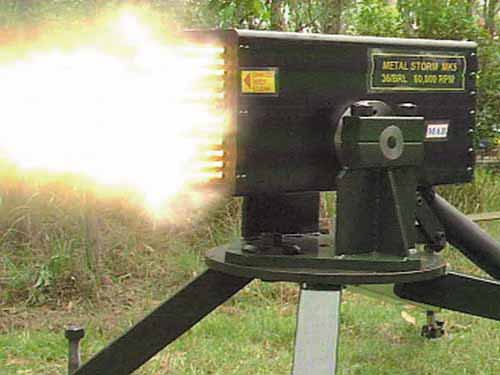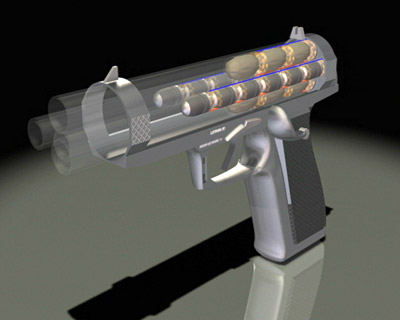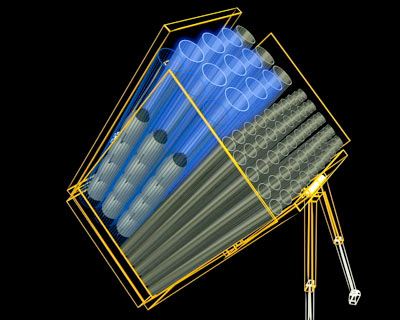
It has no moving parts. Yet, it can fire
standard, small-caliber projectiles from multiple barrels
at speeds up to one million rounds per minute. Is it still
a gun?
Its creators call it Metal Storm. No
moving parts mean no jams in the traditional sense and a
quiet operating mechanism. The high rate of fire is not
just a function of the number of barrels. The cartridges
are initiated with an electronic impulse.
Building on earlier technology,
successfully demonstrated over the past three years, Metal
Storm continues to try to drag small arms
technology-some might suggest kicking and
screaming-into the computer age. Inventor Michael
O'Dwyer said his Australian-based company, also named
Metal Storm, has found additional applications and new
ways to incorporate other technologies with its own.
Metal Storm still is ranked as a
high-risk technology among the latest in a string of
efforts to achieve a real leap ahead in small-arms
technology. Prototypes have been demonstrated to the
apparent satisfaction of the U.S. Defense Advance Research
Projects Agency. Metal Storm's owners have received more
than $50 million in development dollars from the U.S and
Australian governments.
 Looking
beyond the traditional, a single, or multi-barreled Metal
Storm device could be added to an existing weapon on a
Picatinny rail, or current optics and fire-control systems
could be added to a Metal Storm platform. The company has
taken its 9 mm pistol and incorporated a key control
device to create its own version of a "smart gun" for
possible law enforcement applications. This variant could
fire multiple rounds with a single trigger pull. On
activation, the weapon could send out a "help" signal
on a radio frequency to call for backup. Looking
beyond the traditional, a single, or multi-barreled Metal
Storm device could be added to an existing weapon on a
Picatinny rail, or current optics and fire-control systems
could be added to a Metal Storm platform. The company has
taken its 9 mm pistol and incorporated a key control
device to create its own version of a "smart gun" for
possible law enforcement applications. This variant could
fire multiple rounds with a single trigger pull. On
activation, the weapon could send out a "help" signal
on a radio frequency to call for backup.
The Australian company is partnered with
the U.S.-based SAIC in a DARPA-led contract to develop a
new, lightweight advanced sniper rifle, based on Metal
Storm technology. Rather than depending on larger
calibers-such as .50 caliber or 20 mm-the Metal Storm
advanced sniper rifle would use .45 caliber ammunition,
with thousands of rounds fired at a high rate of fire.
 The
ammunition developed for the sniper version of Metal Storm
comes in two versions. One has a .17 caliber tungsten
sabot fin stabilized projectile. The second variation has
a .22 caliber sabot round that is spin stabilized. Both
variants are caseless and electronically primed. The
ammunition developed for the sniper version of Metal Storm
comes in two versions. One has a .17 caliber tungsten
sabot fin stabilized projectile. The second variation has
a .22 caliber sabot round that is spin stabilized. Both
variants are caseless and electronically primed.
Some of the advantages of the sniper
application noted by its developers include a rapid
reload, since the rounds come in a pre-loaded barrel. This
same technology allows the shooter to quickly change
calibers or ammunition type. It also offers the user the
option to make a quick shift to less-than-lethal, as a
scenario evolves. Because Metal Storm can be programmed to
fire multiple rounds with a single trigger pull at an
extremely high rate of fire, it is conceivable that a
sniper could deliver multiple rounds, a double or triple
tap, at long range, with no recoil between rounds.
Metal Storm's creators reduced the
rate of fire in the sniper version to a more manageable
60,000 rounds per minute to improve the accuracy of a
sniper rifle version. The company has been experimenting
with the sniper rifle for the past year.
Australia's Defense Science and
Technology Organization is looking at various applications
for the technology, including area denial, vehicle
self-defense and a close-in weapon system. The company
also is looking at civilian applications, such as
firefighting.
Australian Weapon
Most recently, Metal Storm was selected
as a component of Australia's Advanced Individual Combat
Weapon, that country's version of the U.S. Objective
Individual Combat Weapon. Still in the concept stage, the
Australian AICW looks like an over-under system, with the
upper barrel firing an air-bursting munition and the lower
firing standard 5.56 x 45 mm ammunition. The standard
Australian-built, Austrian-designed AUG bullpup will
provide the foundation for the new weapon. The
air-bursting munition will be based on Metal Storm
technology. O'Dwyer said it should be possible to apply
the technology to the larger 20 mm round.
Metal Storm was listed on the Australian
stock exchange in 1999 and has raised over $215 million
from private speculators. The corporate strategy to date
has been to concentrate on research and development and
aggressive international marketing to improve the
technology's long term chances of survival.
As with any new technology, Metal Storm
does not come without skeptics. Many of them are
small-arms designers and engineers with years of
experience in research and development, as well as
production engineering. The weapon's inventor is not
from the milieu of the small-arms world. He is an inventor
with "out-of-the-box" ideas.
Most of the questions from experienced
small arms manufacturers involve the physics of firing
multiple rounds simultaneously down a barrel.
Manufacturers wonder about the effects of the gases, which
inevitably must be initiated to thrust any projectile down
the barrel. What impact do the gases propelling one
projectile have upon subsequent projectiles, as they
travel down the barrel and out the muzzle? The high rate
of fire also has some asking about the effects on the
mechanics of the barrel, including wear.
Metal Storm's primary sources of
funding, however, are from government agencies and capital
investors who are used to gambling on promising concepts
and recognize the high-risk nature of this new and
different technology.
Video Presentation
Downloads
Metal Storm is a 100% electronic operating system which
allows for a wide variety of projectiles grouped in tube
containers such as barrels, to be stored, transported and
electronically fired. With no mechanical moving parts,
Metal Storm has the capability to fire a wide variety of
material including fire retardant, bullets, fertilizer and
explosive charges.
Duration: 9 minutes
|
9.5
Mb
RealVideo
Download
|
34
Mb
High Resolution
Mpeg Download |
113
k
Transcript of Video
pdf document |
|